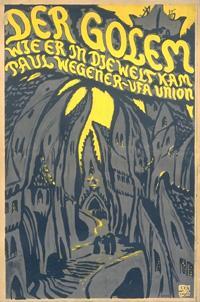The golem is a monster of fascination. It has been the subject of movies from quite an early period. The earliest, now mostly lost, seems to have been Paul Wegener’s Der Golem (1915). This film became the first of a trilogy, with the second (also lost) being, The Golem and the Dancing Girl (also originally titled in German, 1917). The third film mostly survives and is therefore often called The Golem, based on the fact that it is the one we can still see. Der Golem: wie er in die Welt kam (The Golem: How He Came into the World, 1920) is considered a must-see early horror film, although that designation comes from the fact of there being a monster. It’s not scary. It is, after all, a silent film.

Having watched some recent examples of Jewish horror I realized that I’d missed this one and set out to rectify the situation. This film is actually the prequel to the other two, with Wegener’s golem having already established a cinematic presence. I wasn’t sure what to expect from the story, but I supposed that it would be the oppressed Jews creating a golem to protect them and that it would eventually go berserk, as soulless people generally do. It may have helped to have seen the two missing films, I suspect. This golem is made to protect the Jews, but the edict against them is cancelled by the fact that the golem exists. The emperor is impressed with the Jewish magic and allows the Jews to remain in their ghetto. The golem, however, develops feelings for Rabbi Loew’s daughter, which is an interesting twist.
The rabbi does lose control of his creation, and it refused to allow him to deactivate him by removing the secret word revealed by Astaroth, under a star on his chest. A little girl outside the ghetto, picked up by the golem, playfully pulls off the star and saves the day. This really isn’t Jewish horror, at least not in the sense of more recent films. It’s not very close to the Jewish golem legend and saving the Jewish community is left up to a gentile girl. The ending clearly inspired James Whale’s Frankenstein some eleven years later, but the messaging of the film is pretty much what you might expect for a non-Jew trying to tell a Jewish story. The fact that a demon is involved in bringing the golem to life puts us into a more Christianized view of things. Still, this historic film, which is just over an hour in length, started something that has grown more sophisticated as Jewish horror started to come into its own.
